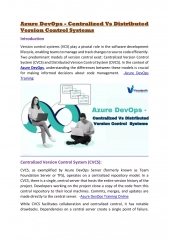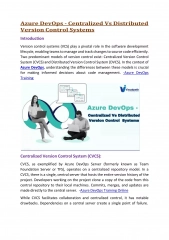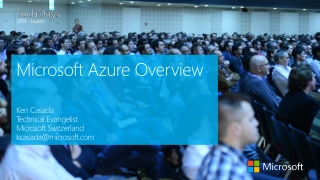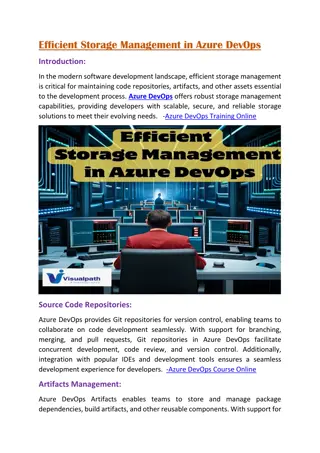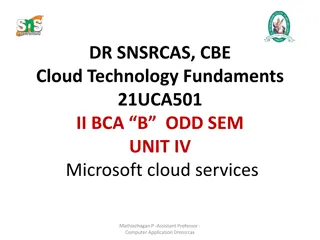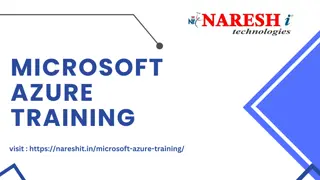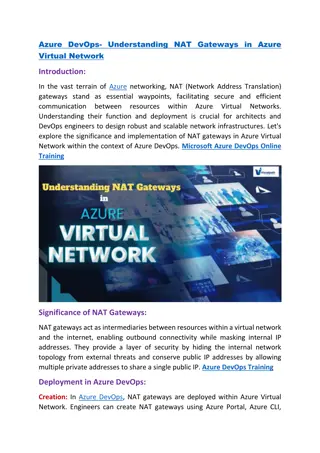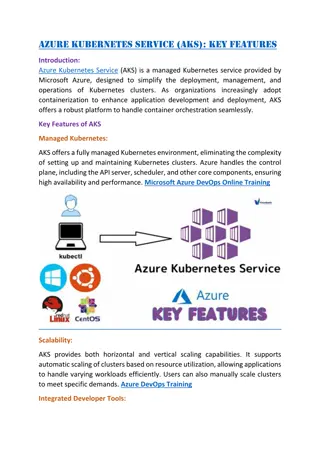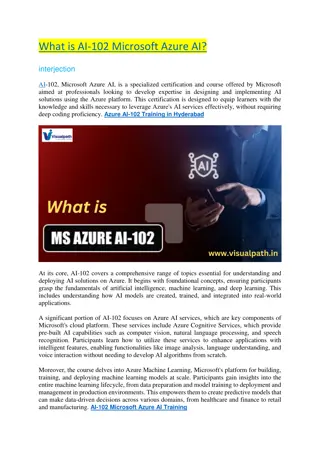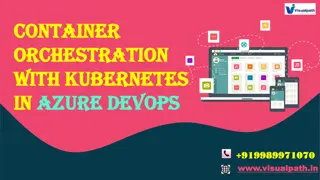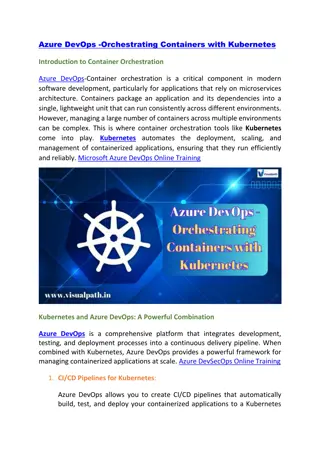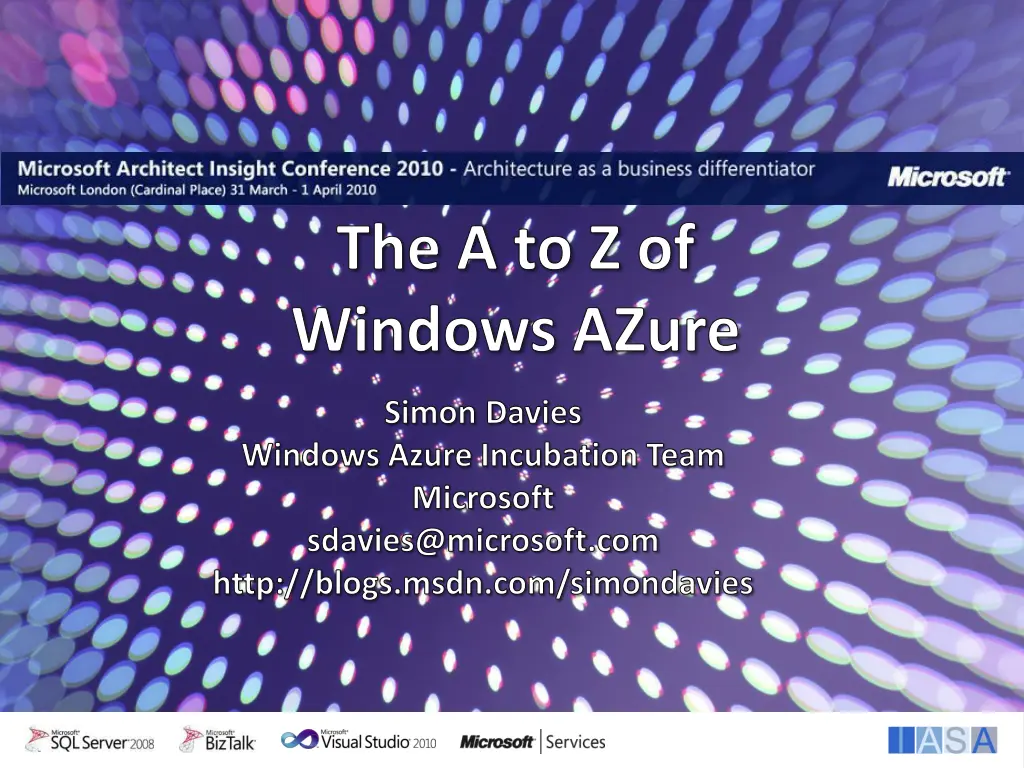
The A to Z of Windows Azure: Technology, Commercial Model, and Future Directions
Discover the comprehensive guide to Windows Azure, covering technology insights, commercial models, workload patterns, and future development paths. Explore the timeline, service architecture, communication models, and key features encapsulated in this detailed resource.
Download Presentation

Please find below an Image/Link to download the presentation.
The content on the website is provided AS IS for your information and personal use only. It may not be sold, licensed, or shared on other websites without obtaining consent from the author. If you encounter any issues during the download, it is possible that the publisher has removed the file from their server.
You are allowed to download the files provided on this website for personal or commercial use, subject to the condition that they are used lawfully. All files are the property of their respective owners.
The content on the website is provided AS IS for your information and personal use only. It may not be sold, licensed, or shared on other websites without obtaining consent from the author.
E N D
Presentation Transcript
The A to Z of Windows AZure Simon Davies Windows Azure Incubation Team Microsoft sdavies@microsoft.com http://blogs.msdn.com/simondavies Interoperability
Objectives of this session Describe the technology Explain the commercial model Consider Workload Patterns and Application Types Discuss Future Direction
Windows Azure TimeLine Oct 2008 1st CTP announced supports .Net Medium Trust code, Blobs, Queues, Table and Automatic Service Management. March 2009 .Net Full Trust, Native Code, Geo-Location, FastCGI May 2009 Storage Enhancements, PHP SDK CTP, new VS tools and SDK. July 2009 New SDK version and Business Model
Windows Azure Timeline Aug 2009 New Blob Features September 2009 Management API, Portal, New Upgrade Options Oct 2009 Eclipse plug in for PHP, Java SDK Nov 2009 CDN and Custom Domains for Blob Storage. Jan 2010 Customer selectable guest OS version Feb 2010 Cloud Drive v1.1 SDK
Windows Azure In One Picture Business Portal Developer Portal Customer Code REST Service Management Service Runtime API Storage Cluster Compute Cluster WA Setup VS Tools Cloud VM WA SDK REST Microsoft Datacenters Desktop
Service Model Service architecture Worker Role Web Role Worker Role A service is made up of components called roles Arbitrary # of endpoints per role Arbitrary # of identical instances of each role, one per VM, variable size Arbitrary # of roles 2 kinds of roles Web Role: We host your role on IIS Worker Role: Provides an entry point for you to run your code, can have both external and internal network conectivity
Service Model Communication (TCP, HTTP, HTTPS) LB Internal to service: Any role instance can reach any endpoint by IP/Port# Port #s assigned by platform, a query API is provided External to service: Outbound: No restrictions Inbound: Single VIP; port slicing for multiple endpoints Developer can specify port # for any input endpoint
Programing Model Code can run with full trust Languages & APIs Support any language supported by Windows Server 2008 Support standard .NET, Win64 APIs Azure Specific APIs Logging And Monitoring Service Configuration Storage Library
What about existing code? Has to fit the service model Will It Run? Windows Non-admin user Copy to Deploy no install General Approach Declare network requirements Copy your code to a compute node on startup Query for IP\Port information Create a process from a Worker Role
Example: Running a Java App Worker Role Process.Start() Worker .class Worker .dll .NET JRE
Windows Azure Storage Blobs Small to very large files Can be block (sequential) or page (random) Drives A page blob formatted as a fixed sizevhd. Can be mounted on a compute instance read\write or read only CDN Content Distribution Network for blob storage Tables Partitioned, dynamic schema, entity sets Queues FIFO like persisted storage for inter process communication All automatically managed by Windows Azure
Service Management Service automatically maintains running service instances failure of hardware or software managed Network automatically managed Portal and API for management operations E.g. deploy app, change configuration Choice of Data Centre Location
Service Management Application Deployment Options Virtual IP Swap Planned Downtime Rolling Upgrade Windows Azure Guest OS Upgrade Options Fix to a specific version via service config Automatic upgrade
Windows Azure Platform Consumption Prices (up to 10 GB DB/month) (up to 1 GB DB/month) Prices shown in USD only International prices are available
Windows Azure Instance Sizes Unit of Compute Defined
Windows Azure Platform Data Transfer North America Region Asia Pacific Region Europe Region N. Europe Sub-region N. Central US Sub-region E. Asia Sub-region W. Europe Sub-region S. Central - US Sub-region S.E. Asia Sub-region On-board to Windows Azure platform at no charge Off peak times defined as: 10pm-6am Mon-Fri & from 10pm-Fri to 6am-Mon for weekends in each designated regional time zones below North America PST = UTC-8 WET = UTC Europe Asia Pacific SST = UTC+8
International Pricing 1. US Dollar (USD) 2. Canadian Dollar (CAD) / FX Rate 1.11 11. Australian Dollar (AUD) / FX Rate 1.25 3. British Pound (GBP) / FX Rate 0.6061 4. Danish Krone (DKK) / FX Rate 5.46 6. EURO (EUR) / FX Rate 0.7092 7. Norwegian Kroner (NOK) / FX Rate 6.15 8. Swedish Krona (SEK) / FX Rate 7.5 (English, French, German, Japanese, & Spanish) 9. Swiss Franc (CHF) / FX Rate 1.1 10. Japanese Yen (JPY) / FX Rate 98 11. New Zealand Dollar (NZD) / FX Rate 1.563
Windows Azure Platform Purchasing Models Subscription Additional Licensing Consumption Pay as you go and grow Pay as you go and grow Value for a commitment Value for a commitment Coordinated purchasing Coordinated purchasing Planned for future Select offers available Now Available Now Discounts for commitment Low barrier to entry & flexibility Centralized purchasing experience Plans for payment predictability Optimized for cloud elasticity Introduction to volume discounts Promotional Offers Partner Discount Integration with Programs Development Pricing
Workload Patterns Optimal For Cloud Growing Fast On and Off Compute Compute Inactivity Period Average Usage Usage Average Time Time On & off workloads (e.g. batch job) Over provisioned capacity is wasted Time to market can be cumbersome Successful services needs to grow/scale Keeping up w/ growth is big IT challenge Complex lead time for deployment Unpredictable Bursting Predictable Bursting Compute Compute Average Usage Average Usage Time Time Unexpected/unplanned peak in demand Sudden spike impacts performance Can t over provision for extreme cases Services with micro seasonality trends Peaks due to periodic increased demand IT complexity and wasted capacity
Application Types Information Sharing Edge of the Enterprise marketing campaigns, customer\employee\partner information portals, mobile enablement ,Data As A Service Compute Intensive Some types of HPC New or extensions to existing applications more likely
Future Direction Improve Symmetry of on-premise and cloud platform across multiple layers of the system Impact many areas Management Tools Server Platform Cloud Platform Application Runtime Capability
Future Direction For Windows Azure: VM Role Admin Access RDP Access More details to come throughout the year Suggest\Vote for enhancements: http://www.mygreatwindowsazureidea.com
Summary Windows Azure is released and commercially available Many scenarios for use today Based on customer\partner feedback, we are: adding functionality, and adding tooling Enhancing business model To enable new scenarios: more sophisticated applications more existing applications More information: http://blogs.msdn.com/windowsazure http://www.windowsazure.com


